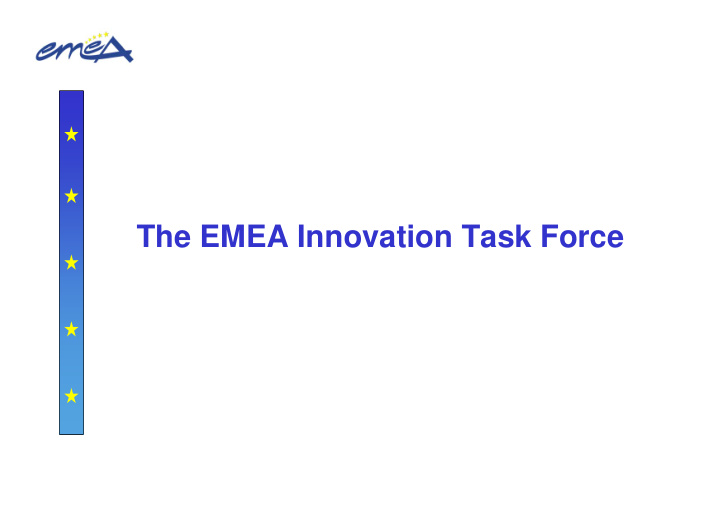



The EMEA Innovation Task Force
Overview of the presentation • Introduction • EMEA Innovation Task Force (ITF) • ITF objectives • Scope of ITF activities • ITF composition • ITF Tasks – Briefing Meetings with sponsors – Regulatory advice on eligibility to the EMEA procedures • Summary of EMEA experience on innovative products • Conclusions
Stimulation of innovation • One of the goals of the long-term strategy of the Agency is to foster research and innovation uptake in the development of pharmaceuticals • EMEA priority set out in the EMEA Road Map and Work Program • The Agency provides sponsors with assistance & guidance through different procedures and initiatives, in particular: – Scientific Advice – SME office and – Innovation Task Force (ITF)
EMEA Innovation Task Force (ITF) http://www.emea.europa.eu/htms/human/mes/itf.htm http://www.emea.europa.eu/htms/human/mes/itf.htm
ITF objectives Established in 2001 to improve early contacts with Sponsors (EU “soft ” landing zone) to: • Identify and monitor progress of emerging science with potential regulatory implications • Provide sponsors (Academia, SMEs, Industry) with a platform for early, informal scientific discussion • Guide through the tools available at the EMEA to meet the needs of sponsors
Products within the scope of ITF activities • Emerging therapies – gene therapy products, cell therapy and engineered tissues, new targeted therapies, nanomedicines, novel routes of administration and delivery systems • Emerging technologies – new development strategies (e.g. genomics), new definitions of target populations in therapeutic fields (e.g. pharmacogenomics), new manufacturing approaches (e.g. use of transgenic plants and animals) • Borderline therapeutics – combination of pharmaceuticals and devices, medicinal products borderline to nutrition supplements for which there is no established EMEA scientific, legal and regulatory experience
ITF composition • Multidisciplinary EMEA group from scientific, regulatory and legal sectors • ITF members are organised in specialised groups as follows: – Cell therapy products – Gene therapy products – Nanomedicines – Genomics – Borderline combination products
ITF Tasks Main tasks: – Briefing meetings with sponsors – Regulatory advice on the eligibility of innovative and borderline products to EMEA procedures (“classification”) To fulfil its tasks the ITF consults: – EMEA scientific committees (e.g. CHMP, COMP) – Working Parties (e.g. Cell Products WP, Gene therapy WP, Biologics WP) – or individual EU experts
Briefing Meetings with sponsors • Early informal dialogue to encourage exchange of scientific and regulatory information during the development process • Provide early guidance on the the different EMEA services (e.g. Orphan Designation, SME incentives, Scientific Advice), pharmaceutical legislation and requirements To request a meeting, sponsors need to: – contact ITF secretariat ( ITFsecretariat@emea.europa.eu ) , – fill in a request form and a briefing document Details on the process are publicly available on ITF website (http://www.emea.europa.eu/htms/human/mes/itf.htm)
Regulatory Advice (Classification) procedure • Innovative products often span regulatory boundaries • The applicable Regulatory Framework is not always easy to define (medicines, combination products, advanced therapies) • However it needs to be clarified early in the development since there are different regulatory requirements for the development of e.g. a medicinal product compared to a medical device • Early dialogue with the Regulatory Authorities is needed • EMEA is not a classification body, but can express an opinion on whether the product in question fulfils the criteria of the medicinal products’ Regulation
Regulatory Advice (Classification) procedure • Provided free of charge within 60 days of receipt of a valid request from an applicant. • Advice prepared by ITF with CHMP/EC involvement, when there is not regulatory precedence • Details on the process are publicly available on the ITF website (http://www.emea.europa.eu/htms/human/mes/itf.htm)
25 21 19 19 20 15 ITF Briefing meetings ITF Regulatory advice 10 7 7 4 5 0 2005 2006 2007 An increasing number of cell-based products, gene therapy and pharmacogenomics-based products have requested EMEA support in recent years L-Antineoplastic and immunomodulating agents (42%) A-Alimentary tract and metabolism (16%) C-Cardiovascular system (12%)
Conclusions Conclusions � EMEA is publicly engaging in support of innovative products � EMEA is publicly engaging in support of innovative products � The ITF model of informal dialogue with sponsors from early � The ITF model of informal dialogue with sponsors from early stages in the development has been proven to be effective stages in the development has been proven to be effective in: in: • Providing sponsors with a better insight on Providing sponsors with a better insight on potential regulatory • implications when developing their products when developing their products • Allowing regulators increase their understanding on emerging Allowing regulators increase their understanding on emerging • science. science. � Early dialogue with the Regulatory Authorities should increase possibilities for marketing authorisation of novel ideas � Opportunities for dialogue in the run-up to implementation of advanced therapies regulation
Thank you! Thank you! Aknowledgements Marisa Papaluca Amati Marisa Papaluca Amati Evdokia Korakianiti Evdokia Korakianiti Frida Riviere Frida Riviere Correspondence to ITFsecretariat@emea.europa.eu
Recommend
More recommend